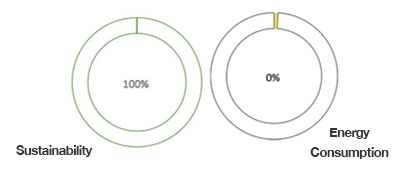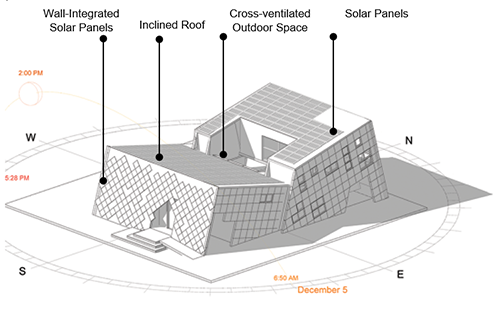
Finding the balance between sustainability needs and creative Architectural form is the cornerstone of the main design approach. This innovative approach will create a forward-looking building that merges all components needed to support sustainability whilst propelling local identity. Accordingly; main design concept relies on adopting passive design strategies to create an architectural mass that reduces the overall energy consumption to the minimum level. Meanwhile the developed building solutions are tailored to the site specifics, constraints and its microclimate.
The building mass evolved from a basic mass achieving the required volume. Passive strategies implementation as well as microclimate conditions directed its development: the mass was split into two parts along the North/South axis. The parts were shifted from each other along the main axis to increase the shaded surfaces. An open space was carved into the middle of the mass, improving cross natural ventilation of the internal spaces, and offering a private, climate moderated outdoor area.

 The design relies on adopting passive design strategies to create an architectural mass that reduces the overall energy consumption to the minimum level. Meanwhile the developed building solutions are tailored to the site specifics, constraints and its microclimate. A responsive approach to the site microclimate divided the building mass along the North/South axis giving rise to an elevated structure in the north-East creating an enclosure of a courtyard in the middle of the mass composition to increase its thermal performance. The roofs were tilted in opposite directions to capture the prevailing wind on one hand, while increasing the roof surface area to allocate the additional solar panels on the other hand. Solar Envelope and fenestration were adapted to respond to the surface orientation. The main challenge considers the potentials related to minimizing solar penetration into the building while enabling extended daylight illumination in most of the interior spaces in addition to maximizing natural ventilation.
The design relies on adopting passive design strategies to create an architectural mass that reduces the overall energy consumption to the minimum level. Meanwhile the developed building solutions are tailored to the site specifics, constraints and its microclimate. A responsive approach to the site microclimate divided the building mass along the North/South axis giving rise to an elevated structure in the north-East creating an enclosure of a courtyard in the middle of the mass composition to increase its thermal performance. The roofs were tilted in opposite directions to capture the prevailing wind on one hand, while increasing the roof surface area to allocate the additional solar panels on the other hand. Solar Envelope and fenestration were adapted to respond to the surface orientation. The main challenge considers the potentials related to minimizing solar penetration into the building while enabling extended daylight illumination in most of the interior spaces in addition to maximizing natural ventilation.
The building design considers sustainability at its essence emerging from an ethical standing point to design and build with future generations in mind. The team is challenged to fulfill the following SDME contests:

